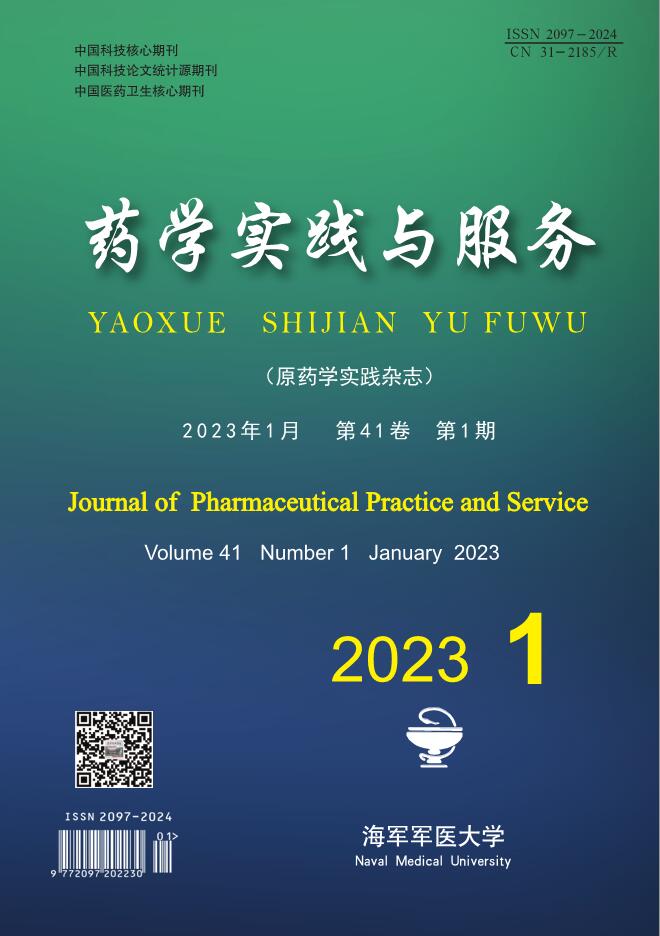-
克罗恩病(Crohn’s disease, CD)是一种病因未明的炎症性肠病(inflammatory bowel disease, IBD)。临床以腹痛、腹泻、肠梗阻等为特点,常伴有肠外表现,并发症多,致残率高,发作与缓解交替出现,治疗难度较大。英夫利昔单抗(infliximab, IFX)是IBD治疗中最早使用的生物制剂,但是随着目前国内广泛应用,有部分IBD患者对IFX表现为失应答。临床药师通过血药浓度监测对1例CD合并低蛋白血症患者出现失应答的原因进行分析,考虑该患者血清白蛋白水平影响药物药动学过程,协助医生共同解决用药问题,以期提高IFX的应答,并对患者进行药学监护。
-
患者,女,53岁,身高165 cm,体重48 kg,体重指数(BMI)为17.63,于2017年7月无明显诱因出现黏液血便,每日4~5次,伴脐周痛,于当地医院对症治疗,症状好转,之后症状间断出现。曾就诊于外院提示溃疡性结肠炎,予口服美沙拉嗪1 g tid,联合美沙拉嗪灌肠液4 g qn,灌肠治疗,症状有所缓解,但无法达到完全缓解。2019-01-21就诊于长海医院,经肛小肠镜检查:回肠多发溃疡,病理:(回肠下段)见固有层较多淋巴结,浆、中性粒细胞浸润,局灶见肉芽肿,符合克罗恩病改变。依据《世界卫生组织克罗恩病诊断标准》,符合节段性病变及全壁性炎性反应,内镜回肠至肛周多发节段性纵行溃疡伴狭窄,确诊克罗恩病,予IFX 300 mg静脉滴注治疗,出院后在进少渣软食的同时口服肠内营养制剂增加营养素的摄入。至2020-03-26期间规律行IFX 300 mg维持治疗,2020-04-23日因患者出现腹痛症状反复,故将IFX剂量调整至400 mg。
患者于2020-06-17再次就诊我院,仍有腹痛腹胀症状,结肠镜:克罗恩病,回肠末端病理示:固有层较多淋巴细胞、浆细胞、中性粒细胞浸润,未见肉芽肿。查炎症因子水平:(白介素)IL-6 23.9 pg/ml,TNFα 133 pg/ml,粪便钙卫蛋白(FC)>1800 μg/g,IFX血药浓度<0.4 μg/ml,抗体血清浓度<4 ng/ml,由于IFX血药浓度低于下限,临床药师与医师分析后,考虑药物剂量不足引起继发性失应答,缩短注射间隔,本次输注IFX后间隔4周返院行IFX治疗。患者白蛋白25 g/L,住院期间输注20%人血白蛋白50 ml,临床药师建议医师对该患者进行全肠内营养支持,每日口服肠内营养粉剂(TP)(荷兰Abbott.Lab.B.V.,批准文号:H20130320)1罐,短肽型肠内营养剂(德国MilupaGmbH,批准文号:H20170170)1盒。患者出院4周后(2020-07-18)返院行IFX 400 mg治疗,查炎症因子水平:IL-6 14.9 pg/ml,CRP 21.4 mg/L,红细胞沉降率 41 mm/H,TNFα 56.3 pg/ml,查炎症因子与炎症指标较前下降,症状有所缓解,疾病活动度下降。
-
患者为中年女性,IFX用药期间临床症状反复,处于疾病活动期,且IFX血清谷浓度<0.4 μg/ml,低于有效的谷浓度范围(3~7 μg/ml),抗体浓度测定<4 ng/ml,未产生抗药抗体。有研究表明,IFX谷浓度水平可预测其治疗CD的疗效[1]。Hibi等认为达到临床反应的谷浓度阈值约1.0 μg/ml [2],在韩国人群中的研究显示基于疾病活动度的谷浓度截断值为0.68 μg/ml[3]。有研究发现,在对IFX治疗最初有应答的IBD患者中,最终也有高达40%的患者由于药物暴露不佳、副作用或其他原因不明的机制而失去反应[4]。结合该患者临床症状及实验室指标,考虑该患者为IFX剂量不足从而引起继发性失应答。
对继发性失应答的患者进行治疗药物监测(therapeutic drug monitoring,TDM)可指导治疗方案的调整 [5]。针对TDM结果,临床药师利用药动学、药效学、临床药物治疗学等知识,综合分析产生该结果的原因,评估该结果对药物治疗效果、安全性及用药依从性等方面的影响,为临床医师确定药物治疗方案、药师实施药物治疗管理及患者自我管理提供参考[6]。针对该患者的TDM结果,临床药师提出以下建议:该患者谷浓度低,抗体阴性,现用剂量400 mg,患者体重48 kg,已经达到8 mg/kg,IFX最高剂量为10 mg/kg,同时考虑免疫抑制剂如硫唑嘌呤可导致严重的骨髓抑制、肝功能异常等剂量依赖性不良反应,建议采取缩短注射间隔,由8周缩短为间隔4周,后期若患者应答情况差,加用硫唑嘌呤联合治疗或更换同类别或跨类别转换治疗。医师采纳,嘱患者出院后4周返院行IFX治疗,后期随访炎症因子与炎症指标较前下降,活动度下降。
-
虽然关于失应答的确切原因还不明确,但是目前研究观点认为导致IFX药物失效可能是由于以下两个关键机制:①药物免疫原性。由于IFX是人鼠嵌合型抗体,存在鼠源成分,因此有可能引发人体免疫系统产生抗药抗体,识别并中和体内药物,增加药物清除率,导致药物浓度的降低。②药动学变化。受疾病严重程度、血清蛋白水平和体重指数等多个因素的影响,体内药物代谢和清除速率发生变化,导致药物浓度偏低。
与传统化学药物不同,IFX是大分子药物,由于其分子质量较大,使其呈现出不同于小分子药物的独特药代特征,几乎不存在经肾清除,一般包括:①通过抗体与Fcγ受体结合,被网状内皮系统的吞噬细胞进行蛋白分解代谢,然后被细胞内的溶酶体降解成肽段和氨基酸;②通过FcRn介导的循环[7]。所以影响这些机制的参数就会导致更多的清除和较低的药物浓度。
患者此次入院,血清白蛋白25 g/L,查既往病史资料,自2020-03-26起血清白蛋白水平一直<30 g/L,处于低蛋白血症的状态,是否血清白蛋白水平影响药物清除及应答?临床药师查阅文献后认为,血清白蛋白水平低会导致外源的IgG即IFX分解代谢增加,清除率增加,从而降低了IFX药物暴露,产生失应答。一项真实世界探索影响IBD患者IFX药动学因素的大型队列研究发现,高滴度ATIs、高体重和低血清白蛋白水平是影响IFX清除的独立因素[8]。有研究利用ACCENT I和REACH试验数据建立非线性混合效应模型,发现当CD患者白蛋白降低时清除率是增加的[9]。Dotan等也发现IFX清除率与白蛋白、体重和ATI等患者因素显著相关,建议对低蛋白血症者缩短给药间隔,体重较低者应给予较高的初始剂量[10]。有研究提出FcRn共同挽救IgG和白蛋白的机制在解释血清白蛋白水平与IFX药动学之间的关系中起重要作用,虽然可能需要进一步的研究来阐明FcRn的作用[11]。该患者住院期间及时静脉输注人血白蛋白纠正低白蛋白水平是合理的。
-
临床药师对该患者进行营养筛查,NRS2002总评分≥3分,同时对当前营养状况进行评估:血生化评价营养指标血清白蛋白25 g/L,前白蛋白115 mg/L,明显偏低,提示患者属于营养状况不良,需加强营养支持。有研究表明,肠内营养不仅可以改善营养状态,还能诱导和维持CD缓解,可能机制主要是:下调促炎因子,发挥抗炎作用,促进肠道黏膜上皮愈合,降低肠道渗透性,且使机体脂肪和蛋白质等大分子致病抗原的含量大大降低, 进而起到减少肠道黏膜抗原暴露的目的,使肠道休息,还可调整肠道菌群[12]。并且不同的配方成分在诱导克罗恩病患者缓解时的疗效无显著差异,蛋白质类型均不影响肠内营养效果[13]。该患者前期一直服用整蛋白型肠内营养制剂,药师认为营养成分完整、接近正常饮食组成、价廉、口感好的整蛋白型肠内营养制剂是适宜的。短肽肠内营养制剂可直接吸收,不依赖于消化酶可快速纠正低蛋白状态,且低脂配方不增加肠道负担。联合使用可以及时补充患者蛋白质,有助于肠道黏膜对蛋白质的吸收,提高血浆前蛋白、白蛋白水平,临床药师建议患者联合使用。2006年欧洲肠外肠内营养学会(ESPEN)推荐缓解期克罗恩病患者:25~30 kcal/(kg·d),活动期CD患者:约高出缓解期8%~10%,该患者进行全肠内营养,联合使用短肽型和整蛋白型制剂,肠内营养粉剂(TP)400 g(1800 kcal)每日一罐,肠内营养粉剂(短肽型)125 g(500 kcal)每日一袋,一日总热量为2300 kcal,是合理的。
-
该患者接受IFX治疗过程中,容易诱发机会性感染,如真菌感染、病毒感染等,这些感染会导致各种感染性疾病,本次治疗前检查无机会感染发生,继续加强监护。针对该患者肠内营养支持的监护,首先要加强营养状况监测,定期筛查营养风险,定期检查微量营养素缺乏情况,如维生素D、B12、叶酸等;其次,进行用药教育增加患者用药依从性和意识,全肠内营养不仅是营养支持,更是一种治疗,能够诱导CD缓解,并可能有助于维持缓解,延缓复发,促进肠黏膜溃疡愈合;最后,密切监测相关并发症,如肠道并发症(腹泻、腹胀、恶心、呕吐等)、代谢并发症(水电解质平衡异常、血糖波动等)。
-
克罗恩病是一种慢性炎症性病变,属于需要长期治疗的疾病。临床药师对患者进行全程药学监护,特别是结合患者合并低蛋白血症的病情,查阅相关文献,分析IFX血药浓度较低的原因,协助医师优化治疗方案,较好地发挥了临床药师进行药学服务实践的作用。该病例提示我们,临床患者使用IFX是具有个体差异的,特别是对于复杂病情的患者,我们应该提高警惕,尤其是要关注血清白蛋白水平对IFX消除以及疗效的影响。
Pharmaceutical care for a Crohn's disease patient with hypoalbuminemia and non-response to infliximab
doi: 10.12206/j.issn.2097-2024.202102009
- Received Date: 2021-02-17
- Rev Recd Date: 2021-07-13
- Available Online: 2023-07-14
- Publish Date: 2023-01-25
-
Key words:
- Crohn’s disease /
- infliximab /
- therapeutic drug monitoring /
- secondary non-response /
- pharmaceutical care
Abstract:
| Citation: | LIN Tingting, ZENG Tingting, TIAN Jing. Pharmaceutical care for a Crohn's disease patient with hypoalbuminemia and non-response to infliximab[J]. Journal of Pharmaceutical Practice and Service, 2023, 41(1): 59-62. doi: 10.12206/j.issn.2097-2024.202102009 |







 DownLoad:
DownLoad: